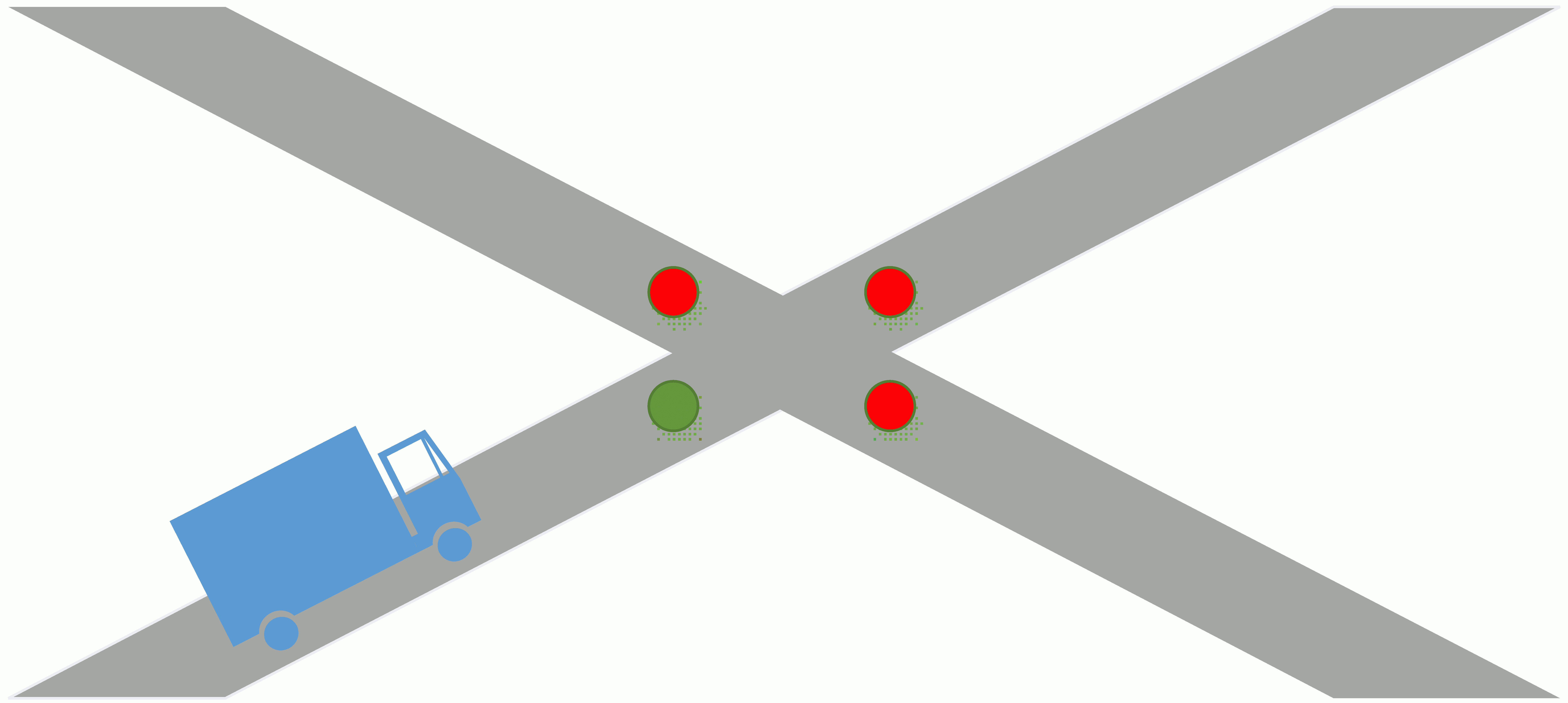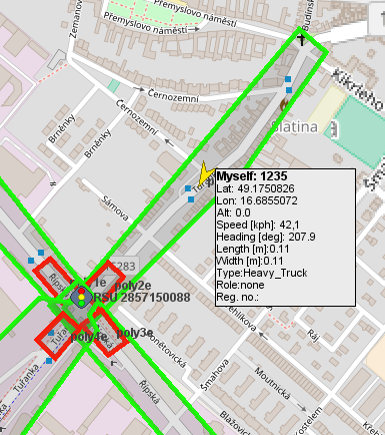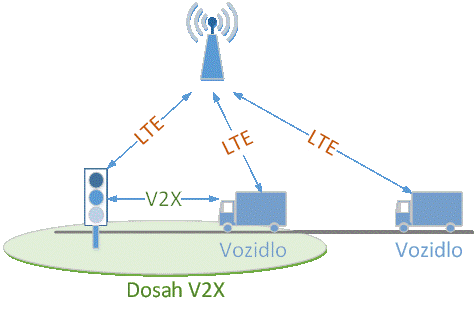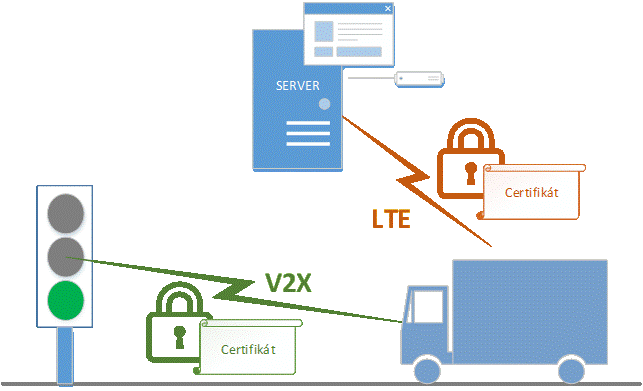Vehicle preferences using V2X
- Articles and technical information
The paper describes an ongoing project testing the absolute vehicle preference of the Fire Rescue Service (FRS) in Brno, which is carried out in cooperation with Brno Roads, the Fire Rescue Service and Patriot, on 5 intersections and 2 vehicles. The basis of the project is our UCU 5.0 communication unit supplemented with a two-channel V2X communication module. It is the use of this international V2X standard in practical operation that makes the project a completely original solution. This is the first installation of a similar system in the Czech Republic.
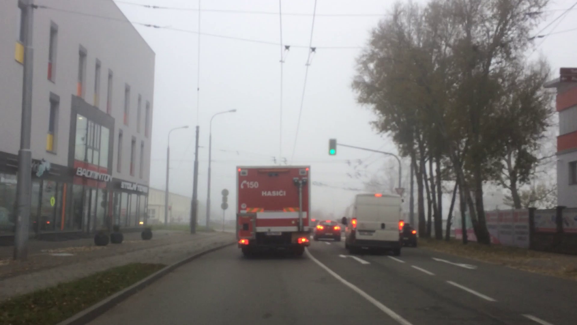
Example of a firefighters' car with preference.
Why V2X communication was chosen
The Fire Brigade vehicle preference is based on the new uniform pan-European standard for vehicle-to-vehicle and vehicle-to-infrastructure communication, the so-called V2X (vehicle-to-everything, or C2X, C2C - car-to-car). This is a standard that will be fitted to all vehicles coming off production lines in the future (e.g. Volkswagen plans to deploy it in vehicles as early as 2019). This will unify all communication between vehicles and between vehicles and the surrounding traffic infrastructure, including intersection controllers.
As this communication is likely to be mandatory for all road users in the near future, its use for communication with the traffic infrastructure is offered as a logical and sustainable option independent of the supplier.
In our system, the V2X standard communication is used for direct and independent communication with the intersection. The range is about 300 meters in built-up areas and over 1 km in open terrain (verified during project implementation). The vehicle transmits information about its status periodically up to 10 times per second (the frequency changes dynamically according to the channel congestion for V2X). The intersection controller also communicates in a similar way and can communicate the status of its signal plan to the surrounding area, for example.
One of the disadvantages of V2X communication is the poorer signal propagation in urban areas, which is due to the 5.9 GHz frequency used. This therefore requires the communication unit to be placed in an elevated position and preferably in the middle of an intersection. A typical location is thus the mast of a traffic light system (SSZ). This location usually already provides good coverage of all approach directions to the intersection.
The general objective of vehicle-to-vehicle and vehicle-to-infrastructure communication is to increase the safety and efficiency of vehicle operation, with the radio information conveying vehicle status to the surrounding environment much faster than the changes can be detected and evaluated by the sensor systems of surrounding vehicles.
These benefits therefore include:
- the fire brigade vehicle informs surrounding vehicles of its passage,
- coordinating the behaviour of the road and infrastructure,
- the possibility of warning of a collision between two consecutive vehicles
- the road is independent of the weather (fog),
The principle of V2X communication. Source: https://www.extremetech.com/extreme/243542-v2x-conquers-bad-curves-construction-zones-red-lights
Principle of fire brigade vehicle preference
Vehicle preference is based on the position of the vehicle, which is obtained from GPS (or other navigation systems such as Galileo or Glonass). If the vehicle reaches a defined area around an intersection, then it can request a preference. The request for preference comes either from the on-board computer or is tied to the status of single-bit inputs, such as the activation of beacons on the fire brigade vehicle. However, the final decision on whether (and when) preference is granted is up to the controller or the communication unit at the controller. Thus, the intersection itself decides when to initiate a signal plan change. It will only set the green in the direction from which the fire brigade vehicle is coming, in order to "clear" the intersection, or at least allow oncoming traffic.
Vehicle communications with the intersection controller shall include units:
- on-board unit (UCU 5.0) in the OBU function,
- an intersection communication unit (UCU 5.0) in the RSU function,
Preference decision
As mentioned, vehicle preference is decided on the basis of vehicle location. This is evaluated according to the parameters specified for the intersection. The specified area is defined within the intersection configuration. The preference then works on the basis of:
- the current position of the vehicle,
- the marked areas on the map,
- the direction of travel,
- beacons on.
Each direction of approach to an intersection has its own defined area (polygon) in which priority is activated - shown in green. This is an area long enough to ensure that the controller has time to change the signal plan and set the desired signal in that direction. When entering the area, the preference will be activated. If the car leaves the area, the preference is terminated. The red area in the picture is the so-called exit polygon. After passing it, it is assumed that the car has successfully passed through the intersection and that the priority request is therefore terminated.
The polygons are a more robust and versatile variant of the familiar check-in and check-out points from public transport vehicles. However, login points are defined on the vehicle, while polygons are defined for the intersection. The situation where all the decision logic is at the intersection has the advantage that the intersection knows the traffic condition in the vicinity much better than the arriving vehicle. With significantly more frequent communication with the vehicle, the controller has much better information about the location of the vehicle and therefore does not have to rely on a single point. It can then better determine when to initiate a preference.
Communication between vehicle and intersection
Our system is designed to handle preference in a unified way for both the IZS and possibly for public transport vehicles (urban public transport and regular VLD). The behaviour for each of these vehicle types is of course different, but the technology is identical, using the same international standard. Our idea was to create a system in which it would be possible to put only one communication unit to the controller for all purposes.
The system is based on a combination of two communication interfaces: a short range V2X and a standard LTE mobile connection. The roles and characteristics of each interface are as follows:
- LTE - mobile connection for early intersection information - it is slower, less reliable, but works regardless of distance - it has a long range. It is therefore mainly intended for 'advance warning' that a vehicle is approaching an intersection.
- V2X (C2X) - direct and independent medium-range communication according to the international standard - it is a fast and reliable communication, but with a smaller range.
Securing communication against misuse
Each vehicle transmits its basic status (position, speed, acceleration, direction of travel, etc.) and the type of vehicle and its role - for example "fire brigade vehicle in action" or "public transport vehicle" - continuously and periodically for typically 100 ms. These are messages called CAM (Cooperative Awareness Message). This message is picked up by all vehicles and infrastructure elements in the vicinity and can be acted upon - for example, to warn the driver of the imminent passage of a fire brigade vehicle or of an imminent collision with another vehicle, etc. In addition, as already written, it is possible to use another message to inform the controller of a preference request.
In order to prevent misuse of this information (which is a direct possibility with vehicle preference), the communication is supplemented by a high level of security which cannot be achieved with standard radio communication. Security is thus an essential element of V2X communication. Messages sent from the vehicle are digitally signed, and the junction will only 'allow preference' to the vehicle that has 'correctly' signed the message for it. In addition, the keys to the signatures are stored in the HW module, so it is not possible to access them and hack into the system.
This will result in:
- A high level of security using authorization and authentication methods,
- each message is digitally signed and sent with a certificate authorising the sending of that message. The issuer of the certificate in this case would most likely be the intersection operator.
Vehicle and junction solution
Currently, prototype UCU 5.0-V2X units are in use, which have generic features to verify many possible functions. The location of the unit in the vehicle is on its roof and at the intersection it is on the traffic light pole. The units arranged in this way then allow a V2X communication range of up to 1000 m in line-of-sight. Communication with intersection controllers is via RS 485 interface.
Prototypes of V2X units based on UCU 5.0 - on the left - an external unit placed on a traffic light and on the right - a unit placed on a fire truck.
Conclusion or write up about the project
From our point of view this is a very promising solution based on existing ETSI - G5 standards, i.e. a pan-European solution. The advantage is the speed of communication and the near impossibility of misuse due to digital signatures of communication. The use of the very powerful UCU 5.0 communication units enables the connection of cameras to the system. For example, camera streams from the vehicle going to the intervention and possibly also from the intervention itself are already being sent to the fire brigade control room. It is also possible to connect public transport to the system and thus operate a multi-priority preference method for fire brigade vehicles, ambulances and public transport (public transport and VLD). This means that e.g. the fire brigade vehicle will have absolute priority, then ambulances can follow according to the acute situation, then e.g. trams and then other public transport vehicles as is the current practice.
In the project, we want to continue to test the setting of preferences at intersections just for ambulances.
Example of test runs of a fire brigade vehicle with absolute preference from 16.11.2017 (taken from the fire brigade website):
They wrote about the project:


